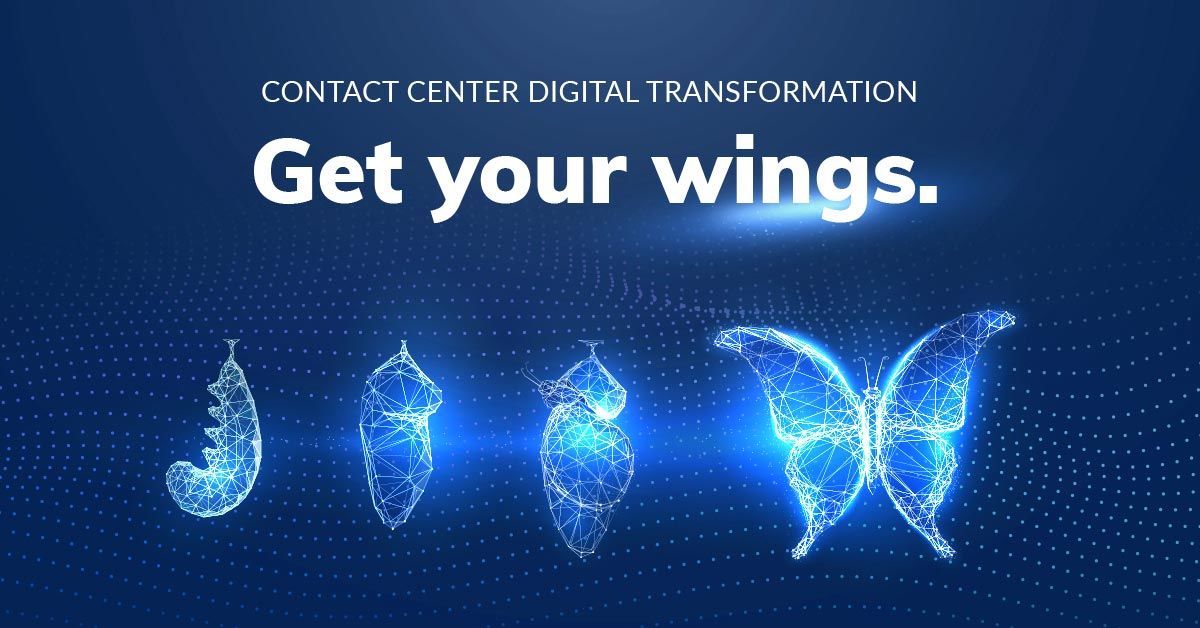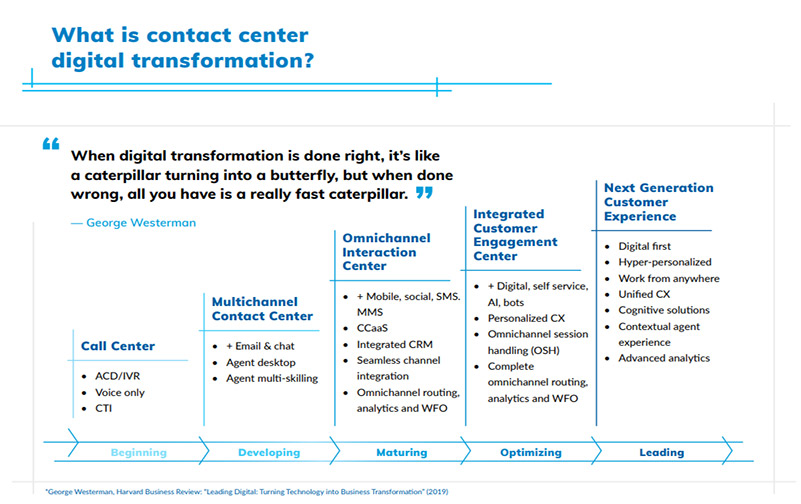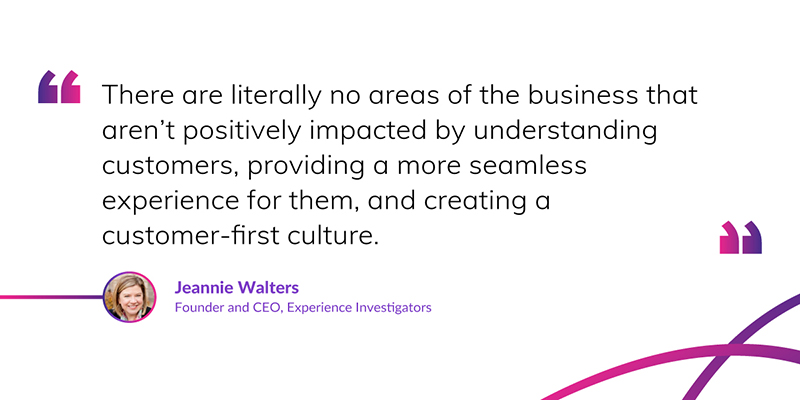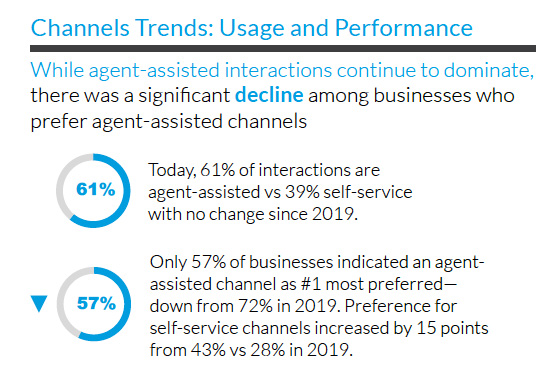I recently placed an online order for a new fishing line from a sporting goods store, whose previous point of contact consisted of just a voice line (and an online presence of a Facebook page with the occasional picture of the trophy bass). Now, due to modernizing and updating technology and processes, the business’s e-commerce functionality is linked with inventory management and their loyalty program system. They also implemented new channels of contact, such as live chat on their Facebook page, for customer service purposes. The result was a much more satisfying experience that made me feel that I was no longer interacting with a "small" company. And don't worry, the bass is still on the home page.
Consumers have come to expect enterprise-feeling seamless omnichannel digital experiences regardless of the size of the business they're dealing with. People love the local, personal, and one-on-one vibe of small businesses, but they also want convenient and competent service. This is particularly true when interacting with contact centers. Customer preferences for how they interact with companies are changing at a rapid pace, and businesses are quickly evolving their service offerings to meet these demands. The result is that call centers look very different than they did just five years ago.
Small to mid-size business contact centers (those between 30 and 300 seats) are increasingly eliminating old, outdated legacy technology and replacing it with solutions that provide seamless, consistent, and satisfying experiences throughout the customer journey. When customer interactions dominantly took place over voice, smaller businesses could manage without feature-rich call routing. However, digital channel preferences and higher customer expectations present an opportunity for small and mid-size businesses to adapt in order to keep up or risk losing customers to (often larger) competitors. Modernization is a significant undertaking, but successful mid-size and small businesses have always had the necessary aptitude to adapt to change. Going digital will help them remain relevant in a changing world.
If you’re not sure where to start, check out some Contact Center Software Buying Advice or the Cloud contact center buyer’s guide.
What is digital transformation? Why is it such a big deal?
Digital transformation is not digitizing technology. Rather, it is the process of using technology to streamline processes, tear down silos, and enhance customer experience. It ensures that the full business itself is customer-centered and that people, tools, processes, and technology subsequently fall in line. Complete digital transformation impacts the entire business.
Let's look at how digital transformation has changed an entire industry. Banking used to be a branch- and teller-centric industry. If you needed cash from your account, you had to go to the bank to withdraw it. This was very problematic if you needed cash after hours or on Sundays when banks were closed (how did we survive that?). Fortunately, ATMs became ubiquitous in the 1980s, allowing people to deposit checks and withdraw cash any time they wanted without teller assistance. Online banking created a further evolution by empowering customers to complete more tasks for themselves. Mobile apps enable self-service from people's devices of choice. And modern innovations are making cash obsolete. (You might want to cash in that giant cup of pennies you have stashed in your basement…)
Some companies have been more successful at digital transformation than others. For example, Nike uses digital technologies to transform how customers select athletic shoes. Mobile app users upload pictures of their feet, and a recommendation engine suggests the best shoes for them based on 13 data points. Additionally, information captured by this process is not only used for new product development but also stored and analyzed using AI for future customer service purposes. Nike also uses modern technology to streamline internal operations. For example, by digitizing 6,000 footwear materials, Nike has empowered design teams to collaborate more efficiently and customers to have access to products more quickly.
Digital transformation isn't just for the big guys─small businesses also need to embrace modern technology to compete and grow. Unfortunately, small to mid-size businesses are often shackled by legacy systems that don't provide the capabilities needed to be flexible and nimble. This is especially true of voice-only or inflexible contact center technology that doesn’t support the digital needs of the customer, which can make agents and customers feel like the business is stuck in the past.
Research by Tech Aisle revealed that 82% of small businesses "are already on their digital transformation journey."1 This could include everything from implementing AI-infused accounting software to offering customers free Wi-Fi and analyzing their browsing behavior, to putting smart fleet management solutions in place. Digital technologies change the way small businesses operate and enable them to provide loyalty-building CX in all touchpoints within the customer journey.
Digital transformation is particularly important for small business contact centers, enabling businesses to quickly adapt to customer experience trends. Strong digital platforms enable small businesses to explore new ways of satisfying customer needs across a spectrum of channels. Modernized call centers can serve customers efficiently and effectively, and act as a catalyst for business growth.
What it takes for a total small business digital makeover
Any business that wants to go digital should keep CX at the forefront of design decisions. This is especially true of contact center digital transformations, where everything from workforce management software to self-service solutions and reporting applications can either directly or indirectly impact your customers. But even new back-office systems can impact CX. For example, new order fulfillment systems will impact delivery times and new accounts payable systems will affect customer billing.
It may not be top of mind in the heat of a significant system implementation, but customers like accurate bills and receiving the right products on time. In my case, I would have been very disappointed if my favorite fishing shop had sent me a hat instead of a fishing line. That might have been an experience bad enough to drive me back to corporate sporting goods chains (okay, maybe not).
Ensuring your contact center doesn't make mistakes that drive your customers to bigger competitors requires a CX platform that can deliver exceptional experiences during every interaction and in every engagement method. This means that if you offer chat, voice, and email support, customers should receive consistently satisfying service and be able to move across channels seamlessly.
Post-sale service and support is just one type of interaction your company needs to handle. Customers also look to your business to help them search for products, make purchases, and more. And they use a variety of methods to accomplish these tasks, including search engines, mobile apps, and your company website. CX isn't confined to customer support when something breaks or needs fixing, which means you need a powerful CX platform that empowers your agents to manage customer experiences wherever they occur.
What makes a CX platform "powerful?" If you're selecting a new CX platform for your small or mid-size business's digital transformation, look for the following features and capabilities.
Customer journey orchestration
Have you ever attended a live symphony concert or watched one on TV? I'm always amazed by how more than 50 musicians playing different instruments and playing different parts can synchronize to create such beautiful music. This doesn't happen by accident; they plan, practice and the conductor provides leadership to ensure the outcome is a coordinated work of art.
Customer journey management is a lot like producing a successful orchestra concert. Smooth, satisfying journeys don't happen organically; they require detailed planning and design, as well as leadership and finely tuned instruments to ensure the different touchpoints are in harmony.
For contact centers, the "instruments" that produce harmonic customer journeys are the different applications that can be found in industry-leading CX platforms. These applications work in tandem, matching customer intent with the right resolution across any touchpoint and method of interaction. This includes:
- Automatic call distributors (ACDs). A good ACD is both an instrument and a conductor. It performs omnichannel routing that enables customers to seamlessly move across channels. And when ACDs are enhanced with AI routing, they can route customers according to their preferences and emotions. Call center digital transformations aren't possible without a powerful ACD.
- Digital and voice channels. If you're using legacy on-premises contact center technology, chances are high that your voice channel isn't integrated with your digital channels. This makes capacity management difficult and requires your agents to inefficiently toggle through multiple applications. Your digital transformation should include a solution that integrates all your support channels.
- Predictive dialer. Many small businesses rely on outbound campaigns to generate new business and sell more products to existing customers. This is a sensitive part of the journey that needs to be orchestrated just right. A good predictive dialer can help you make the most of your outbound lists by maximizing agent productivity. And you know that tell-tale pause people hear before the agent is connected? That jangles the ears like a dozen out-of-tune violins, so look for a "pause-less" predictive dialer.
Digital self-service
Today's consumers are used to, and often prefer, solving their own problems. Give your customers what they want by providing effective, digital self-service options that can help them with issue resolution 24/7. There are many solutions available, including the following:
AI-powered bots. My friend was raving the other day about his recent interaction with his bank's online chatbot. The bot conversationally walked him through a mortgage application and helped him transfer money to his son's checking account. I nodded, smiled, and said, "Welcome to my world." As a CX professional, I've long known that chatbots have the potential to transform digital customer experiences, and I'm happy to say chatbot technology is finally beginning to reach that potential. Chatbots come with a wide range of capabilities and prices, making them a good DIY solution for businesses of all sizes.
Learn what chatbot technology is most fitting for your organization in this Chatbot Starter’s Guide.
- Conversational IVRs. Interactive voice response (IVR) systems are the original call center self-service solution, and, thankfully, they have improved greatly over the years. Raise your hand if you've ever reached an IVR menu and immediately pressed zero or said, "Representative." Fortunately, your customers don't need to do that if you have an AI-infused conversational IVR. In fact, they might come to value the experience of talking to your IVR in natural language to completely bypass the menu and get right down to solving their own problems.
- Knowledge base. A good knowledge management system that is available to both customers and agents can provide valuable information and provide a single source of truth across channels. According to Accenture, 73% of customers prefer to visit a company’s website before contacting customer service.2 Including a knowledge base in your digital transformation could be a huge opportunity to satisfy customers and reduce your contact center's workload.
Workforce engagement
Workforce engagement isn't just about back-office call center processes. Workforce engagement practices impact how long your customers wait in queue and the quality of the agents they interact with. For many organizations, workforce engagement tasks, such as volume forecasting, are manual, time-consuming, and error-prone. Processes this important should be digitally transformed. Here are some of the tools available to modernize your workforce engagement.
- Workforce management. Do your workforce management staff (or you) have to be spreadsheet wizards to produce forecasts or agent schedules? As your business grows and you add more digital channels, there will come a time when a mass of linked spreadsheets is no longer an adequate solution. Plan to implement workforce management software as part of your digital transformation.
- Quality management. Every effective contact center has quality management to some degree, but some do it more efficiently than others. Like workforce management, quality management processes are often overly manual, which can mean agents aren't receiving timely coaching and leaders don't have an accurate view of overall quality and potential weaknesses. If this rings a bell, consider implementing quality management software that automates workflows, simplifies form design, and provides dashboards that make it easy for managers to know if the quality is meeting standards.
- Performance management. Agent-assisted channels such as voice, email, and chat are still the most used customer service methods, making agents as important as ever for creating lasting relationships with your customers. Because 79% of buyers would change suppliers/retailers if they had a poor experience,3 you need to use tools that empower and motivate agents to continuously improve their skills. Good performance management software includes agent dashboards and gamification in a social environment that encourages teamwork.
- Real-time interaction guidance. Ever wish you could clone yourself and your supervisors? Small contact center supervisors often wear several hats, which means that additional duties like quality monitoring and agent scheduling can get in the way of agent development. Real-time interaction guidance software leverages artificial intelligence to listen to all voice interactions, determine customer sentiment, and coach agents in real-time on soft skills that can improve the interaction. Sounds magical, right? It is.
Customer analytics
A huge benefit of successful digital transformation is how it dismantles data silos, enabling consolidation and historical data analysis. This empowers businesses to know their customers better and make data-driven decisions. To get the most value from their call center data, small to mid-size businesses should include some of the following tools in their transformation plans:
- AI sentiment and interaction analytics. If you've ever wondered what your customers are really thinking, interaction analytics help by analyzing all contacts from all channels. This lets you know if your customers are happy or mad and identifies problems and trends. Best of all, you don't need to be (or hire) a data expert to use the software and understand its output, making it a great tool for small businesses that want the customer and operational insights formerly only available to larger enterprises.
- Customer survey software. Of course, another way to gain customer insights is simply to ask customers for their feedback. Personally, I prefer companies to send email surveys so that I can fill them out when I have the time. With the right survey software, you can send surveys to customers in their preferred communication channels, and you can configure the surveys to measure customer satisfaction, Net Promoter Scores, customer effort scores, and more.
- Call center reporting and business intelligence. I've worked with new clients who have shared stories about their struggles to get basic data from their former legacy ACDs. Having inadequate reporting and business intelligence is like asking a conductor to lead the symphony blindfolded or with no sheet music to guide him. Call centers are fast-paced environments that generate a lot of data. To effectively manage them, small to mid-size businesses need tools that produce real-time insights.
AI and process automation
AI and process automation enable businesses to do more with less, while also enhancing CX. That's probably why 66% of businesses report using at least one AI channel.4 These businesses are positioning themselves for the not-so-distant future, when as many as 95% of customer interactions will be backed by AI algorithms.5
Artificial intelligence solutions make self-service smarter, improve IVR experiences, increase forecast accuracy, and so much more. These days, AI can be found all over the call center. And when used with automation solutions, such as robotic process automation, AI can facilitate end-to-end automation of repetitive, administrative tasks. This is a great way for small businesses to add low-cost capacity.
The capabilities of modern contact center software
We've covered a lot of ground discussing possible technology for your digital transformation. But what's the end game? Below are just a few examples of the new capabilities small to mid-size businesses could have, and how these capabilities make daily operations run that much smoother.
Customer channel choice
Offering one or two support channels isn't enough these days. Our consumer research revealed that 90% of consumers say they are more willing to do business with a company that provides more ways to communicate.6 Your customers are used to having choices when they communicate with businesses. Providing convenient channel options will help you meet customer expectations and should lead to higher customer satisfaction.
Satisfying and cost-effective customer self-service
Consumers' desire for channel choice includes the option to help themselves. People self-serve at gas stations, grocery stores, airports, and banks. If you're worried about self-service not providing the personal touch small and mid-size businesses are known for, consider this: 84% of consumers are more willing to do business with companies that offer self-service options.7 Even better, it’s a cost-effective way to add capacity as your business grows.
Effective workforce management
As a successful small to mid-size business leader, you're skilled at getting the most from your resources. Industry-leading workforce management software can make your management of call center costs even more effective. With optimized forecasts and schedules, your agent staffing will meet projected demand so that service levels are fulfilled and idle time is minimized. And if things don't go according to plan, automated intraday management provides you with the agility to quickly adjust your staffing levels. Agent wages are a call center's largest cost category, which means call center leaders need effective tools to closely manage staffing.
Begin your own digital transformation
Now for the coda; or the ending of a piece of music. Flexibility allows small businesses to adapt to quickly changing business conditions. To stay viable in today's environment, companies are prioritizing modernization. To digitally transform their call centers, small businesses should implement a robust CX platform that enables them to fulfill customer preferences, better manage costs, and position them for future CX trends.
To learn more about the customer experience that gets you, and to speak to a Digital CX expert who can provide more information about you can transform your contact center, visit the NICE CXone Digital CX platform page.
Speak to a digital expert today, or download the small and mid-size business contact center buying guide.
1 Tech Aisle: The twin ladder approach to delivering digital transformation for SMB and Midmarket firms (2018)
2 Accenture: Next Generation Customer Service (2019)
3 Bloom Reach: The State of Commerce Experience (2021)
4 NICE CXone: CX Transformation Benchmark Global Consumers (2020)
5 Servion: What Makes Emerging Technologies The Future Of Customer Experience? (2018)
6 NICE CXone: Customer Experience (CX) Transformation Benchmark, Global Consumers (2019)
7 NICE CXone: CX Transformation Benchmark Global Consumers (2020)








